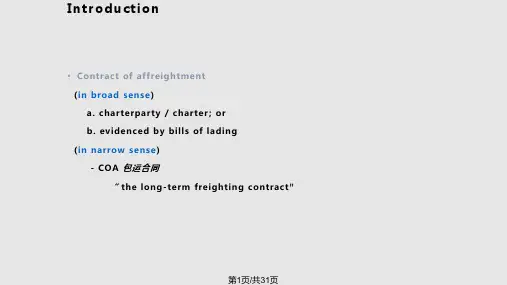对外经贸英语装运条款 合同写作19页PPT
- 格式:ppt
- 大小:2.21 MB
- 文档页数:10

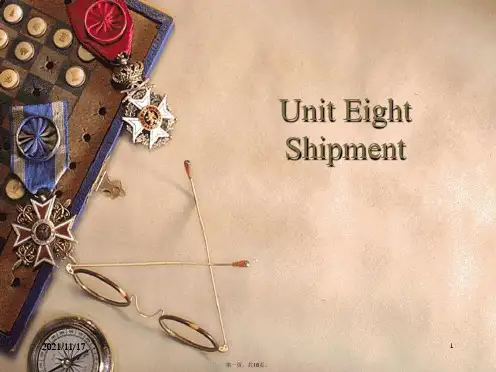

外经贸英语精讲班第19讲课件讲义(环球职业教育在线)外经贸英语精讲班第19讲讲义填制合同(2)课本练习1P162练习(1)合同号码:97—331卖方:山东土畜产进出口公司买方:鹿特丹食品进出口公司商品名称:花生米规格:2002年产大路货数量:50公吨单价:CIF鹿特丹每公吨3,550美元总金额:177,500美元包装:双层麻袋保险:由卖方按照发票金额的110%投保一切险和战争险装运港:中国青岛目的港:鹿特丹唛头:由卖方选定交货期:2002年11月支付条款:不可撤销的即期信用证签约地点和日期:2002年5月10日于山东青岛SALES CONTRACTContract No. 97-331Sellers: Shandong Native Produce and Animal By-Products Import and Export CorporationBuyers: Rotterdam Foodstuffs Import and Export CompanyThis contract is made by and between the Buyers and the Sellers, whereby the Buyers agree to buy and the Sellers agree to sell theunder-mentioned commodity according to the terms and conditions stipulatedbelow:Commodity: Groundnut kernelsSpecifications: FAQ2002 CropQuantity: 50M/TUnit Price: At US$3,550 per m/t CIF RotterdamTotal V alue: US$177,500 (Say US Dollars One Hundred And Seventy –SevenThousand Five Hundred Only)Packing: In double gunny bagsInsurance: To be covered by the Sellers for 110% of the invoice valueagainst All Risks and War RiskTime of Shipment: During November 2002Port of Shipment: Qingdao of ChinaPort of Destination: RotterdamShipping Mark: At Sellers’optionTerms of Payment: By irrevocable L/C available by draft at sightDone and signed in Qingdao of Shandong on this 10th day of May, 2002.课本练习2P164练习(2)卖方:北京轻工业进出口公司买方:纽约贸易总公司商品名称:永久牌自行车规格:MB28型数量:1,000辆单价:CIF纽约每辆70美元总金额:70,000美元包装:木箱装装运期:2003年1月31日前自中国港口至纽约,允许分批装运和转船付款条件:凭不可撤销信用证付款,于装运期前一个月开到卖方,并于上述装运期后15天内在中国议付有效。
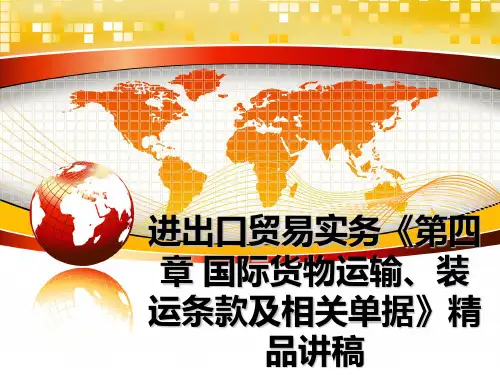

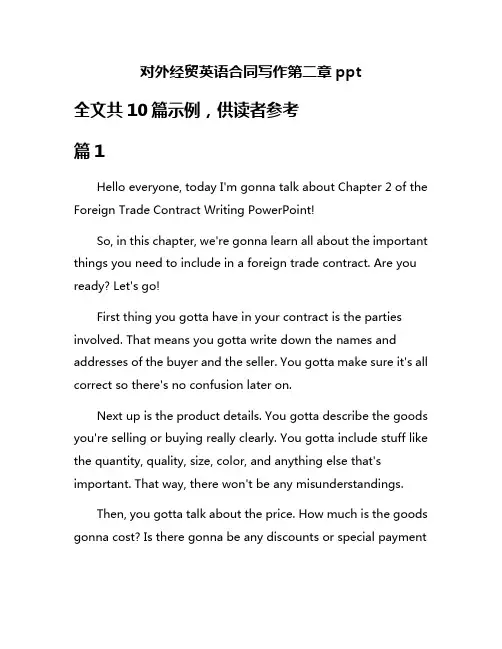
对外经贸英语合同写作第二章ppt全文共10篇示例,供读者参考篇1Hello everyone, today I'm gonna talk about Chapter 2 of the Foreign Trade Contract Writing PowerPoint!So, in this chapter, we're gonna learn all about the important things you need to include in a foreign trade contract. Are you ready? Let's go!First thing you gotta have in your contract is the parties involved. That means you gotta write down the names and addresses of the buyer and the seller. You gotta make sure it's all correct so there's no confusion later on.Next up is the product details. You gotta describe the goods you're selling or buying really clearly. You gotta include stuff like the quantity, quality, size, color, and anything else that's important. That way, there won't be any misunderstandings.Then, you gotta talk about the price. How much is the goods gonna cost? Is there gonna be any discounts or special paymentterms? Make sure you write it all down so everyone knows what's going on.After that, you gotta talk about the delivery terms. When and where is the goods gonna be delivered? Who's gonna pay for the shipping? Make sure you include all the details so there's no problems later.And last but not least, you gotta include the payment terms. How and when is the buyer gonna pay for the goods? Are there gonna be any penalties for late payments? Make sure it's all clear so there's no surprises.And that's it for Chapter 2 of the Foreign Trade Contract Writing PowerPoint! Make sure you include all these important details in your contract so everything goes smoothly. And remember, if you have any questions, just ask your teacher or a grown-up for help. Thanks for listening, bye-bye!篇2Chapter 2: Important Points in Writing Foreign Trade English ContractsHi guys! Today we are going to talk about some important points in writing foreign trade English contracts. Are you ready? Let's get started!1. Contract Parties: First, we need to identify who the parties are in the contract. This means we need to write down the names and addresses of the buyer and seller.2. Product Description: Next, we need to describe the products that are being bought or sold. We should include details like the quantity, quality, and specifications of the products.3. Price and Payment Terms: We also need to mention the price of the products and how and when the payment will be made. This includes details like the currency to be used and the payment method.4. Delivery Terms: It's important to specify when and where the products will be delivered. We should also mention who will be responsible for the transportation and insurance of the goods.5. Quality Control: We should include information about any quality control requirements or standards that need to be met for the products.6. Inspection and Acceptance: This section should outline the procedures for inspecting the products upon delivery and what will happen if the products do not meet the agreed-upon standards.7. Force Majeure: This is a fancy term that basically means unexpected events that can't be controlled, like natural disasters. We should include a clause that outlines what will happen if a force majeure event occurs.8. Dispute Resolution: Lastly, we should include a section that outlines how any disputes between the parties will be resolved. This could include things like arbitration or mediation.That's it for today, guys! Remember, it's important to pay attention to these points when writing foreign trade English contracts to ensure a smooth and successful business transaction. Thanks for listening!篇3Welcome to the second chapter of our Outsourcing and Foreign Trade English Contract Writing ppt! We're going to continue learning about how to write contracts in English for international trade. Let's get started!First, let's review what we learned in the first chapter. We talked about the importance of using clear and concise language in contracts. We also learned about the different parts of a contract, such as the parties involved, the agreement terms, and the signatures. Remember, it's important to pay attention to detail when writing a contract!Now, let's move on to the second chapter. In this chapter, we're going to focus on the specific language and terms that are commonly used in international trade contracts. These terms are important to know because they can impact the rights and responsibilities of the parties involved.One term you may come across in a trade contract is "FOB," which stands for "Free On Board." This term is used to indicate where the responsibility for goods transfers from the seller to the buyer. If the contract specifies "FOB Shanghai," for example, the seller is responsible for the goods until they are loaded onto a ship in Shanghai. After that, the buyer is responsible for the goods.Another important term to know is "Incoterms." Incoterms are a set of international rules that define the responsibilities of buyers and sellers in international trade transactions. These rules cover things like delivery terms, transportation costs, and risk ofloss. It's important to familiarize yourself with these terms so you can accurately and effectively write contracts.In addition to understanding specific terms, it's also important to know how to structure a contract effectively. A well-written contract should clearly outline the rights and obligations of each party, as well as any terms and conditions that need to be met. Remember to use clear and concise language, and to avoid any ambiguity in your writing.Finally, it's crucial to thoroughly review and revise your contract before finalizing it. This will help ensure that all parties are in agreement and that there are no misunderstandings or disputes down the line. Remember, a carefully written contract is the key to successful international trade!That's all for the second chapter of our Outsourcing and Foreign Trade English Contract Writing ppt. Thanks for joining us, and we'll see you in the next chapter!篇4Chapter Two: How to Write an International Trade ContractHello everyone! Today we are going to learn about how to write an international trade contract. A contract is a veryimportant document that both parties need to follow when they do business together. Let's learn how to write a good contract!1. IntroductionWhen writing an international trade contract, you need to start with an introduction. This part should include the names of the parties involved, the date of the contract, and the purpose of the contract. It's like saying hello and explaining what the contract is all about.2. DefinitionsNext, you need to define all the important terms in the contract. This is super important so that everyone knows exactly what they are agreeing to. For example, if you are selling apples, you need to define what type of apples you are selling and how many.3. Rights and ResponsibilitiesIn this part, you need to clearly state what each party's rights and responsibilities are. This could be things like who is responsible for shipping the goods, who is responsible for paying for the goods, and what happens if there is a problem with the goods.4. Payment TermsPayment terms are also super important in a contract. You need to state when and how the payment will be made. This could be in cash, by bank transfer, or some other way. Make sure to be clear about the currency being used too!5. Delivery TermsDelivery terms are all about how the goods will be delivered. You need to state where the goods will be delivered, when they will be delivered, and who is responsible for the cost of delivery. This way everyone knows what to expect.6. Inspection and AcceptanceThis part of the contract is all about how the goods will be inspected and accepted. You need to state who will inspect the goods, when they will be inspected, and what happens if the goods are not accepted. This helps to avoid any misunderstandings.7. Dispute ResolutionLastly, you need to include a section on how to resolve any disputes that may come up. This could be things like mediation or arbitration. This part is important so that both parties know what to do if there is a problem.In conclusion, writing an international trade contract is super important when doing business with someone from another country. By following these steps and being clear and detailed in your contract, you can avoid any misunderstandings and have a successful business relationship. Thank you for listening, and good luck with your contracts!篇5Hey everyone! Today I'm going to talk about the second chapter of writing an international trade contract in English. It's super important to know how to write a good contract so both parties can understand what they're agreeing to. Let's get started!First, you gotta have a clear title for the contract. This tells everyone what the contract is all about. Make sure the title is simple and easy to understand.Next, you need to have a section for the parties involved. This is where you write down the names of the companies or people who are making the contract. It's important to include all the details like addresses and contact information.After that, you should have a section for the scope of the contract. This is where you talk about what the contract is for andwhat each party is agreeing to do. Make sure to be really clear so there's no confusion later.Then, you need to have a section for the terms and conditions. This is where you write down all the rules and regulations of the contract. It's super important to be specific so everyone knows what's expected of them.Next, you should include a section for payment terms. This is where you talk about how and when payments will be made. Make sure to include everything from the amount to the due date.Lastly, you need to have a section for signatures. This is where both parties sign to show they agree to the contract. It's like saying "I promise to do my part." Make sure to have space for everyone to sign.And that's it for the second chapter of writing an international trade contract in English! Remember to be clear, specific, and careful when writing a contract. It's super important to make sure everyone understands and agrees to the terms. Good luck!篇6Chapter 2: Writing an International Trade ContractHey guys! Welcome back to our presentation on writing an international trade contract in English. In this chapter, we will learn about the key components of a contract and how to include important details to protect both parties involved in the trade.1. Introduction:- Start with a friendly greeting and introduction.- Outline the purpose of the contract and what it will cover.2. Parties Involved:- Clearly state the names and roles of the parties involved in the contract.- Include contact information for easy communication.3. Goods or Services:- Describe in detail the goods or services being traded.- Include specifications, quantities, and quality standards.4. Price and Payment Terms:- Specify the price of the goods or services and how it will be paid.- Include any terms related to payment such as currency, payment method, and schedule.5. Delivery and Shipping Terms:- Outline the delivery terms including shipping method, time, and location.- Include information on packaging, inspection, and acceptance of goods.6. Force Majeure and Dispute Resolution:- Include clauses for unforeseen circumstances (force majeure) that may affect the contract.- Define the process for resolving disputes between the parties.7. Governing Law and Jurisdiction:- Specify the governing law that will apply to the contract.- State the jurisdiction where any legal disputes will be settled.8. Signatures and Date:- Have both parties sign the contract to show agreement.- Include the date of signing to make the contract legally binding.That's it for Chapter 2! Remember to include all the important details in your contract to avoid any misunderstandings or disputes in the future. Stay tuned for Chapter 3 where we will discuss negotiation strategies and tips. See you next time!Thank you for reading!篇7Chapter Two: Basic Clauses in Foreign Trade English ContractsHello everyone! In this chapter, we are going to talk about some basic clauses in foreign trade English contracts. Are you ready? Let's go!1. Parties to the Contract: This clause is super important because it tells us who are the people or companies involved in the contract. It usually includes the names and addresses of the parties.2. Subject of the Contract: This clause tells us what the contract is all about. It includes details about the products or services that are being bought or sold.3. Quantity and Quality: This clause is all about how much of the product or service is being bought or sold, and what the quality standards are.4. Price and Payment Terms: This is where we talk about how much money is going to be paid for the products or services, and when and how the payment is going to be made.5. Delivery Terms: In this clause, we talk about how the products or services are going to be delivered, when they will be delivered, and who is responsible for the delivery costs.6. Inspection and Acceptance: This clause is about how the products or services will be inspected and accepted by the buyer.7. Force Majeure: This is a fancy term that means unforeseen circumstances that might prevent one party from fulfilling their obligations under the contract. This clause helps to protect the parties in case of such events.8. Governing Law and Dispute Resolution: This clause tells us which country's laws will govern the contract and how any disputes will be resolved.That's all for now! Stay tuned for the next chapter where we will talk about more advanced clauses in foreign trade English contracts. Bye-bye!篇8Chapter 2: Writing an International Trade ContractHello everyone! Today we are going to learn about how to write a contract for international trade. A contract is a super duper important document that makes sure all the details of a trade agreement are clear for both parties. Let's get started!1. Introduction- Start off by introducing the parties involved in the trade agreement. This could be the buyer, seller, and any other important people or companies.2. Terms and Conditions- Write down all the important terms and conditions of the trade agreement. This could include things like the price of the goods, the quantity that will be traded, and the delivery and payment terms.3. Quality Standards- Make sure to include information about the quality standards of the goods being traded. This is super important to make sure both parties are happy with the products they receive.4. Delivery- Write down all the details about how and when the goods will be delivered. This could include the method of transportation, the delivery date, and any other important details.5. Payment- Don't forget to include information about how the payment will be made. This could be in cash, by bank transfer, or through another method. Make sure it is clear and agreed upon by both parties.6. Dispute Resolution- Sometimes things don't go as planned, and disputes can happen. Make sure to include information about how disputes will be resolved, whether through mediation, arbitration, or another method.7. Signatures- Finally, make sure both parties sign the contract to show that they agree to all the terms and conditions. Signatures are super duper important to make the contract legally binding.And that's it! Now you know how to write an international trade contract. Make sure to read through the contract carefully and ask for help if you don't understand something. Contracts are super important to make sure that trade agreements go smoothly. Thanks for listening! Let's go write some contracts!篇9Hello everyone! Today I'm going to talk about Chapter Two of writing an international trade English contract. Let's get started!First of all, remember to include all the important information in your contract. This includes the names of the parties involved, the products or services being traded, the terms of the agreement, and the payment terms. It's super important to make sure everything is written down clearly so that there is no confusion later on.Next, you'll want to make sure you include any specific requirements or conditions that need to be met. This could include things like quality standards, delivery schedules, or anyspecial packaging requirements. It's important to be as detailed as possible so that everyone is on the same page.Don't forget to include any clauses for disputes or conflicts that may arise. This could include things like arbitration procedures or what happens if one party doesn't fulfill their end of the agreement. It's always good to have a plan in place in case something goes wrong.Finally, make sure you include a section for signatures and dates. This is super important because it shows that both parties agree to the terms of the contract and when the agreement was made. It's like saying "Yep, we're good to go!"So there you have it, Chapter Two of writing an international trade English contract. Remember to include all the important information, be super detailed, plan for any issues that may come up, and make sure everyone signs on the dotted line. Thanks for listening, and I hope this helps you in your future business ventures!篇10Hi guys! Today, I want to talk to you about writing a PowerPoint presentation for the second chapter of aninternational trade contract in English. It may sound a bit boring, but don't worry, I'll try to make it fun and easy to understand!So, let's start with the basics. When you're writing a PowerPoint presentation for a contract, you need to make sure you include all the important information. This includes things like the names of the companies involved, the products or services being traded, the terms of the agreement, and any other important details.You also need to make sure your presentation is clear and easy to follow. Use simple language and include lots of pictures and diagrams to help explain the information. Remember, the goal of a PowerPoint presentation is to make it easy for your audience to understand the contract, so make sure you're using clear and concise language.Another important thing to remember when writing a PowerPoint presentation for a contract is to be professional. This means using proper grammar and spelling, and making sure your presentation looks neat and organized. You want to make a good impression on your audience, so take the time to make sure your presentation is well-written and well-organized.Finally, don't forget to practice your presentation before you give it. This will help you feel more confident and prepared, and will make sure your presentation goes smoothly.I hope this helps you understand how to write a PowerPoint presentation for the second chapter of an international trade contract in English. Good luck, and happy writing!。
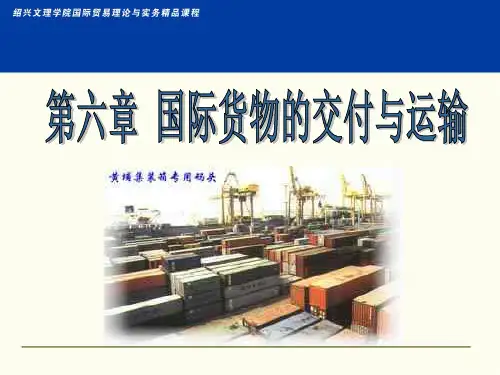
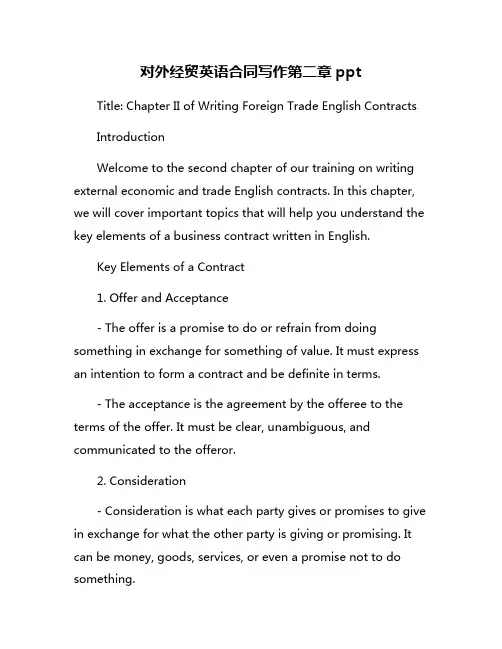
对外经贸英语合同写作第二章pptTitle: Chapter II of Writing Foreign Trade English ContractsIntroductionWelcome to the second chapter of our training on writing external economic and trade English contracts. In this chapter, we will cover important topics that will help you understand the key elements of a business contract written in English.Key Elements of a Contract1. Offer and Acceptance- The offer is a promise to do or refrain from doing something in exchange for something of value. It must express an intention to form a contract and be definite in terms.- The acceptance is the agreement by the offeree to the terms of the offer. It must be clear, unambiguous, and communicated to the offeror.2. Consideration- Consideration is what each party gives or promises to give in exchange for what the other party is giving or promising. It can be money, goods, services, or even a promise not to do something.3. Intention to Create Legal Relations- For a contract to be legally binding, both parties must intend for it to be legally enforceable. This intention can be inferred from the circumstances in which the contract was made.4. Capacity- Both parties entering into a contract must have the legal capacity to do so. This means they must be of sound mind, of legal age, and not under the influence of drugs or alcohol.5. Legality of the Object- The purpose of the contract must be legal. Contracts that involve illegal activities or objects are not enforceable by law.6. Certainty and Possibility of Performance- A contract must be certain and capable of being performed. The terms of the contract must be clear, definite, and capable of being carried out.ConclusionUnderstanding the key elements of a business contract is essential for successfully writing and negotiating external economic and trade agreements. By following these principles, you can ensure that your contracts are legally enforceable andprotect the interests of both parties involved. Thank you for joining us for Chapter II of our training, and we look forward to continuing our discussion in Chapter III.。
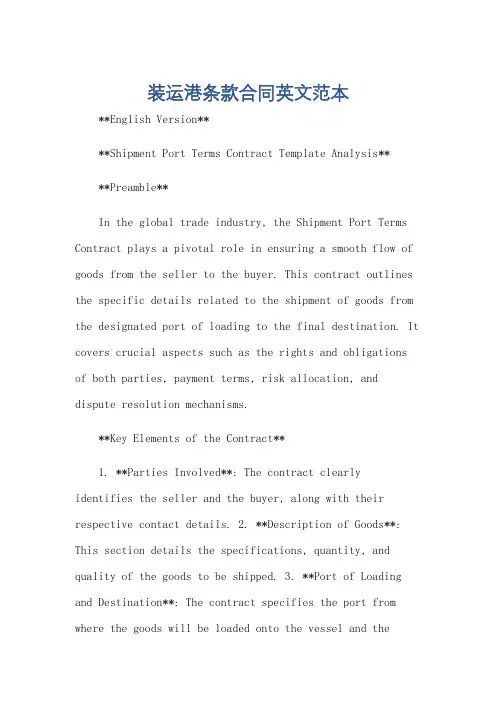
装运港条款合同英文范本**English Version****Shipment Port Terms Contract Template Analysis****Preamble**In the global trade industry, the Shipment Port Terms Contract plays a pivotal role in ensuring a smooth flow of goods from the seller to the buyer. This contract outlines the specific details related to the shipment of goods from the designated port of loading to the final destination. It covers crucial aspects such as the rights and obligations of both parties, payment terms, risk allocation, and dispute resolution mechanisms.**Key Elements of the Contract**1. **Parties Involved**: The contract clearlyidentifies the seller and the buyer, along with their respective contact details. 2. **Description of Goods**: This section details the specifications, quantity, and quality of the goods to be shipped. 3. **Port of Loading and Destination**: The contract specifies the port from where the goods will be loaded onto the vessel and thefinal destination port. 4. **Shipment Date and Duration**: The contract outlines the agreed-upon shipment date and any associated deadlines. 5. **Payment Terms**: Details of the payment method, such as cash on delivery, letter of credit, or advance payment, are included. 6. **Risk Allocation**: The contract clarifies who bears the risk during transportation, such as loss or damage to the goods. 7.**Dispute Resolution**: Mechanisms for resolving any disputes that may arise during the shipment process are outlined. 8. **Force Majeure**: Clauses related to unforeseeable events that may affect the shipment, such as natural disasters, are included.**Contract Execution**Once the contract is agreed upon by both parties, it becomes legally binding. Both parties are expected toadhere to the terms and conditions outlined in the contract. Breach of contract can result in legal action and financial penalties.**Importance of the Contract**The Shipment Port Terms Contract ensures transparency and clarity in the shipping process. It provides a legalframework for both parties, enabling them to understand their rights and obligations. By specifying the terms and conditions, the contract helps in avoiding misunderstandings and disputes, promoting a smooth and efficient shipping process.**Conclusion**In summary, the Shipment Port Terms Contract is a crucial document in international trade. It ensures a smooth and efficient flow of goods from the seller to the buyer, outlines the rights and obligations of both parties, and provides a mechanism for dispute resolution. By adhering to the terms and conditions of the contract, both parties can ensure a successful and mutually beneficial trade transaction.**Chinese Version****装运港条款合同范本解析****前言**在全球贸易行业中,装运港条款合同在确保货物从卖方顺利运送到买方方面发挥着至关重要的作用。
